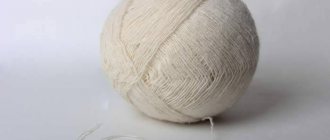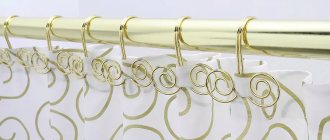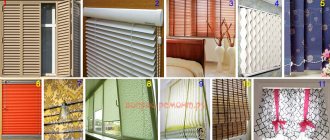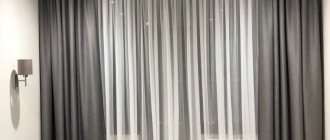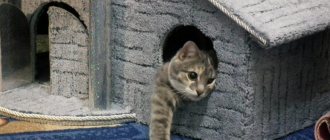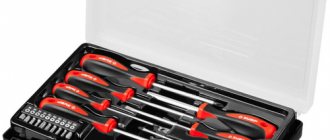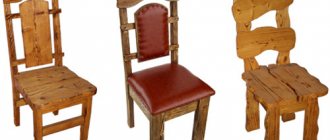Many textile products such as curtains, drapes, lambrequins, frills on bedspreads, sofa and chair covers can be decorated with beautiful folds, which are created by various folds: one-sided, bow, counter
At the end of the article, watch the video on how to make folds without markings.
First, let's decide what types of folds we can use for variety in sewing curtains and lambrequins.
All types of folds are described in three options:
- one-sided folds,
- counter folds,
- bow folds.
One-sided folds are folds laid in one direction through a certain distance between them. We have already encountered this type of fold in dejabo, where one-sided folds face one direction. You can see the calculation of such folds on the page of this website. Dejabo pattern, construction.
In this lambrequin, the folds on both sides are one-sided, laid towards the center, only the central fold is counter-fold, as in a mold:
A counter fold consists of two one-sided folds directed towards each other, as in this figure:
How to make folds on a curtain?
Assembling a curtain with your own hands can be done in two ways:
- using a special braid;
- manually.
A distinctive feature of the first method is its simplicity and high speed. To form soft waves it is enough:
- purchase curtain tape with the required assembly factor from a specialized store;
- attach the braid, pull the threads located on it;
- straighten the bends carefully;
- tie the ends of the threads.
The result is smooth, uniform assemblies. Disadvantages of this method:
- it is not suitable for decorating dense fabrics;
- the threads may fray over time, and the braid will have to be replaced;
- Using tape you cannot make curly large folds.
More expressive options are obtained manually, but this process is labor-intensive. Also here you will have to make a preliminary calculation of the size, number of folds and, if necessary, the distance between them.
What is curtain tape
Curtain tape is a narrow (up to 10 centimeters) polyester braid that is sewn to the top edge of the curtain. The formation of folds on the canvas occurs due to the tightening of threads located inside the braid; depending on the complexity of the drapery, there can be from 2 to 5 such threads.
Polyester as a manufacturing material was not chosen by chance. Unlike any textile fabric, it does not lose its functional properties during use - when washing, the braid does not shrink, which is dangerous due to its narrowing and, as a result, deformation of the folds and patterns on the fabric.
In addition to its decorative purpose, the braid also plays a functional role - it contains loops that are used to attach curtains to curtain rods.
Types of folds
Most often, when making curtains or lambrequins with your own hands, you get three fold options:
- one-sided - the fabric is laid evenly or at intervals in one direction in even waves;
- bow - are one-sided folds directed in different directions, the finished structure looks like a flat bow;
- counter - the opposite of bow ones, in them, on the front side, the folds of the fabric are directed towards each other.
Important
It will be interesting to look at a curtain in which one-sided folds go towards the center towards each other, and the central gather is counter.
Application in the interior of premises
Curtains with drapery of various types are used to decorate a variety of rooms. The choice of fold type depends on the type of fabric chosen and its density.
Kitchen
In the kitchen it is common to use less dense curtains. Preference is given to thin, easily draped fabrics.
Living room
Living rooms are a special category of premises. In such places it is customary to place curtains with lambrequins. It is popular to use different types of tucks to decorate the same fabric, with tassels and fringes as additional decoration.
Bedroom
In this case, dense materials are used that can create the necessary twilight in the room to ensure a restful sleep. When decorating a room, curtains should be in harmony with the surrounding interior.
Children's
To decorate children's rooms, window curtains with bright patterns are often chosen. When draping such fabrics, the location of the pattern should be taken into account. You cannot choose massive, heavy types of folds.
What calculations are needed?
Before carrying out the calculation, it will be necessary to measure the length of the cornice and decide on the method of processing the side edges. The depth of assembly depends on the density of the fabric and the size of the window (the smaller, the narrower the parts should be made). Experts advise taking the depth of the part within 14-20 cm.
Unilateral
An example of calculating such a model for a cornice 1.2 m or 120 cm long. The width of each finished part is 10 cm.
You can calculate the required footage using the formula:
cornice length * coefficient + seam allowances
1.2 * 3 + 0.03 = 3.63 m = 363 cm.
If one piece of fabric is missing, then when stitching you need to make sure that the seam gets as close as possible to the inner fold line.
Bow
Bow pleats on curtains come with or without gaps. Any part consists of an external assembly width (a) and two internal widths (c).
Solid models
An example of calculating a continuous assembly (without gaps) for the above cornice. For this option, the coefficient is 3. Therefore, the fabric footage is determined as in the previous case.
Calculation of the number of bows:
cornice length / fold width
120/10 = 12.
Option with gaps
If you have chosen a fairly dense fabric for sewing a window curtain with your own hands or you need to save material, use bow folds with intervals of different sizes. The gathering coefficient depends on the ratio of the width of the fold (a) and the gap (b):
- a = b – the coefficient is assumed to be 2;
- b = ½ a - the coefficient will be equal to 2.5.
An example of calculation for the previously selected cornice with a coefficient of 2. The distance between the individual parts and the width of the fold is taken to be 8 cm.
- Let's calculate the fabric footage:
cornice length * coefficient + seam allowances
1.2 * 2 + 0.03 = 2.43 m = 243 cm.
If you have little experience in sewing with your own hands and doubts arise, it is better to add 15-20 cm in case of errors when laying the gathers.
The number of bows is:
cornice length /(a+b)
120/(8+8) = 7,5
Round to the nearest whole number – 8.
- Specify the size of the assembly and the gap:
a+b = 120/8 = 15 cm.
Therefore, the width of the fold and the gap between the individual parts are 7.5 cm.
After this, you can start decorating the fabric.
Decoration of curtains, design options, examples, combination with the style in the room
Curtains are considered one of the very first inventions of man. At first they were used only to protect the premises from prying eyes. Over time, in Ancient Egypt, curtains began to be decorated with improvised materials. And only later in Byzantium, the design of a window could eloquently tell about the status and wealth of its owner. The first decoration of Byzantine curtains was natural Chinese silk.
A stylish lambrequin made of leather is a very original solution
Today, decorating a window and making it a work of modern art is not at all as difficult as it seems at first glance. A little time, imagination and the result will surprise you.
This elegant curtain tie is a real find. Harmonizing in color and style with the braid and the curtain itself, it adds chic to the entire composition.
An elegant pair - a caramel-colored silk curtain with a rope tie
Roman blinds look elegant without additional elements. The right fabric and effective attachment to the cornice are a decoration in themselves. Subtle colors are combined with wall decoration and the color of the cornice.
Roman blinds look beautiful on their own, so they don’t need additional decor.
Accents when decorating a window in a classic style are tassels and a lambrequin. Brushes must be the correct color: either the same color as the curtains, or a couple of shades darker or lighter. Lambrequin is suitable only for rooms with high ceilings. You can choose fabric, rigid or combined construction.
Ribbons, tassels and bows will complement the design of the window space. Volumetric decor will add luxury, while light and elegant options will make the interior romantic.
The combination of Roman and French curtains looks stylish and very unusual. Fabric of contrasting colors, braid and tassels make the interior unique, and at the same time functional.
This combination of curtains is suitable for an interior in a classic style.
Beads are selected for decoration with special care. Their task is to complement the design concept, and not to distract attention to themselves. Transparent beads are the most “harmless” option.
The addition to the thread curtains, which themselves look like decoration, is chosen very carefully. In this case, picking up the correct color scheme and avoiding excessive shine.
A combination of thread curtains of different colors looks interesting
Important! The smaller the room, the more neat and restrained the decor should be. Large tassels, beads and other accessories are appropriate only in large rooms with high ceilings.
How to lay one-sided models?
Laying one-sided assemblies is not very difficult. To do this you should:
- mark the fold and alignment lines, setting aside segments equal to the width of the fold (10 cm in the example);
- lay the first piece - take the fabric at the level of the third mark and pull it to the first, pin it together (line 2 will be inside the fold);
- move the fourth and pin at the level of the second and so on until the end of the material;
- after forming all the assemblies, they should be secured with machine stitching;
- treat the top with curtain tape, having previously pulled out the strings from it, or with decorative braid.
Styles
On the yoke
This model allows you to effectively emphasize a wasp waist and create a beautiful, slender silhouette. Skirts made of heavy, shiny silk or light, delicate chiffon look especially impressive.
With elastic band
A universal model, indispensable for hot summers. A gentle, romantic option for an informal setting. Light fabrics such as chiffon are perfect for sewing such skirts.
How to create bow folds?
In bow versions, the fold lines are located at the back. The central part (bow) is located on the face of the curtain, and the folds are connected on the wrong side.
When marking bow pleats, it is important to always start with a value of c. In the future, this distance is not laid down, but is wrapped on the opposite side. Next, you should make the markings according to the calculation (for continuous ones, 10 cm, for the option with intervals, 7.5 cm each). For greater convenience in the latter case, it is better to mark the gaps with colored chalk or a felt-tip pen.
After applying the markings, you can begin decorating. For solid model:
- lay the first bow - move the fabric at the level of the first mark to the beginning of the fabric, and align mark 2 with 3 and pin it. In this case, the fold lines should meet in the center of the bow. After this, the extreme bend can be released;
- second bow - combine mark 4 with 3, and 6 with 5. Pin both folds;
- continue until the end of the fabric;
- stitch and finish the top.
For the spaced option, the first bow is formed as described above. For the second bow: combine mark 5 with 4, and pull 7 to 6. Pin and similarly form the remaining bows and process the top of the curtain.
Sewing curtain tape
To sew the braid to the curtain you will need the following tools:
- Sewing machine;
- Tape measure;
- Chalk;
- Scissors;
- Iron.
By the way, folds on curtains can be formed without braid. In industrial conditions, a special folding foot is used for this, but such a device is not cheap, and there is no point in buying it for one-time use at home.
Sewing is performed in the following sequence:
- We process the upper cut of the curtain fabric - tuck it inward by 5-10 centimeters (depending on the thickness of the braid) and secure it with two longitudinal stitches;
- Iron the folded fabric along the entire length of the curtain;
- We lay out the braid on the curtain and turn its outer sides 2 centimeters inward. It should be located at a distance of at least 1 cm from the top cut of the canvas, and 5 cm from its sides;
- We sew the braid to the fabric - we make a longitudinal stitch on the upper and lower contours, and a stitch near each internal tightening rope.
- Now you need to tuck and stitch the edges of the curtain, which we left on the sides of the tape. The main thing is to first release the tightening threads so that you don’t have to cut the fabric later.
All that remains is to iron the fabric at the sewing site and you can start tightening.
Conclusion
DIY assemblies can be done using curtain tape or by hand. The first method is simple and does not require much effort. The second is more labor-intensive, but you can create beautiful, stylish folds.
Typically, curtains have one-sided, counter or bow options with or without gaps. The calculation and sequence of actions to create the necessary composition depends on this.
How to properly attach eyelets for curtains?
How to sew curtain tape and get a beautiful drapery?
How to make wooden blinds with your own hands?
Manual laying option
Hand-folded tulle requires certain sewing skills, since it mainly consists of thin fabrics that are very slippery and capricious to work with.
The fabric slips and moves in different directions, therefore, if possible, such work should be given to a specialist, and if you still decide to try your hand at the work, follow a few rules.
Seamstress tip:
All sewing lines should follow in the same direction, this will help you avoid skewing the fabric.
Tulle can be folded with different fillings of the fabric. The basis for the calculation is the distance along the cornice. For example, let’s take the distance along the cornice equal to three meters.
Ideally, there should be three times more fabric to place tulle on the fold, that is, 9 meters.
Tulle pleats
The principle of laying can be seen here.
But it’s not always possible to purchase 9 meters. Sometimes you already have fabric with a spacing of less than 1:3, for example 6 meters.
Double filling of tulle involves the arrangement of folds, in which the fold goes through a certain distance, it looks like: fold, distance, fold, distance.
Tulle pleats
Such tulle folds already need to be calculated.
